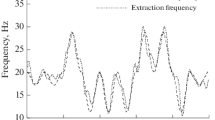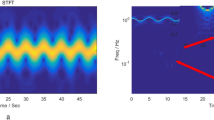Abstract
This paper considers the parameter estimation of multicomponent polynomial-phase signals (mc-PPSs) with orders greater than two. The proposed method combines the product cubic phase function (PCPF) and high-order ambiguity function (HAF) when the mc-PPS orders exceed three. In the proposed method, the HAF is first applied to the observed mc-PPS to produce a cubic phase signal. Second, the algorithm is modified to estimate the parameters of mc-PPS using the CPF. To obtain accurate estimates of the two highest-order parameters (i.e., \( a_{P} \) and \( a_{P - 1} \) of each component), all possible \( a_{P} \) and \( a_{P - 1} \) must be obtained in this step in all combinations of the instantaneous frequencies; then, the maximum absolute value of all sum values must be identified by dechirping with all possible \( a_{P} \) and \( a_{P - 1} \). In addition, non-uniformly-spaced signal sample methods are used to employ fast Fourier transformation in the CPF. The proposed method is different from the PCPF–HAF method proposed by other researchers; it is referred to as the improved PCPF–HAF method and can remedy the shortcomings of the traditional method when estimating mc-PPS parameters. Additionally, the PCPF–HAF method cannot be used to treat multicomponent third-order polynomial-phase signals, but the proposed method can treat them using non-uniformly-spaced signal sample methods. The cross-terms can also be restrained more effectively than with the CPF, resulting in higher accuracy of the estimated parameters and a lower signal-to noise ratio threshold. Theoretical analysis and simulations are presented to support these claims.









Similar content being viewed by others
Explore related subjects
Discover the latest articles, news and stories from top researchers in related subjects.References
Cao, R., Ming, L., Zuo, L., et al. (2018). A new method for parameter estimation of high-order polynomial-phase signals. Signal Processing, 142(2018), 212–222.
Deng, Z., Xu, R., Zhang, Y., et al. (2016). Compound time-frequency domain method for estimating parameters of uniform-sampling polynomial-phase signals on the entire identifiable region. IET Signal Processing, 10(7), 743–751.
Djurović, I. (2017). QML-RANSAC: PPS and FM signals estimation in heavy noise environments. Signal Processing, 130, 142–151.
Djurović, I., & Simeunović, M. (2015). Parameter estimation of non-uniform sampled polynomial-phase signals using the HOCPF-WD. Signal Processing, 106, 253–258.
Djurović, I., Simeunović, M., & Djukanović, S. (2012). A hybrid CPF-HAF estimation of polynomial-phase signals: Detailed statistical analysis. IEEE Transactions on Signal Processing, 60(10), 5010–5023.
Djurović, I., & Stanković, L. (2012). STFT-based estimator of polynomial phase signals. Signal Processing, 92(11), 2769–2774.
Djurović, I., & Stanković, L. (2014). Quasi-maximum-likelihood estimator of polynomial phase signals. IET Signal Processing, 8(4), 347–359.
Djurović, I., Wang, P., Simeunović, M., et al. (2018). Parameter estimation of coupled polynomial phase and sinusoidal FM signals. Signal Processing, 149(2018), 1–13.
Ioana, C., Mars, J.I., Serbanescu, A., Stankovic, S. (2010). Time–frequency-phase tracking approach: Application to underwater signals in a passive context. In Proceedings of ICASSP 2010, Dallas, USA.
Jing, F., Zhang, C., Si, W., et al. (2018). Polynomial phase estimation based on adaptive short-time fourier transform. Sensors, 18(2), 568–580.
McKilliam, R. G., Quinn, B. G., et al. (2014). Polynomial phase estimation by least phase unwrapping. IEEE Transactions on Signal Processing, 62(8), 1962–1975.
O’ Shea, P. (2010). On refining polynomial phase signal parameter estimates. IEEE Transactions on Aerospace and Electronic Systems, 46(3), 978–987.
O’Shea, P. (2002). A new technique for estimating instantaneous frequency rate. IEEE Signal Processing Letters, 9(8), 251–252.
O’Shea, P. (2012). Improving polynomial phase parameter estimation by using non-uniformly spaced signal sample methods. IEEE Transactions on Signal Processing, 60(7), 3405–3414.
Ou, G. J., Yang, S. Z., et al. (2016). A refined estimator of multicomponent third-order polynomial phase signals. IEICE Transactions on Communications, E99.B(1), 143–151.
Ou, G., Zhao, P., Liu, S., et al. (2019). A sparse decomposition-based algorithm for estimating the parameters of polynomial phase signals. IEEE Access, 7(1), 20432–20441.
Peleg, S., & Friedlander, B. (1995). The discrete polynomial phase transform. IEEE Transactions on Signal Processing, 43(8), 1901–1914.
Raković, P., Simeunović, M., & Djurović, I. (2017). On improvement of joint estimation of DOA and PPS coefficients impinging on ULA. Signal Processing, 134, 209–213.
Simeunović, M., Djukanović, S., & Djurović, I. (2014). Quasi-maximum likelihood estimator of multiple polynomial-phase signals. In 2014 IEEE international conference onacoustics, speech and signal processing (ICASSP) (pp. 4200–4203).
Simeunović, M., & Djurović, I. (2011). CPF-HAF estimator of polynomial phase signals. Electronics Letters, 47(17), 965–966.
Simeunović, M., & Djurović, I. (2016). Parameter estimation of multicomponent 2D polynomial-phase signals using the 2D PHAF-based approach. IEEE Transactions on Signal Processing, 64(3), 771–782.
Wang, Y., Zhao, B., & Kang, J. (2015). Asymptotic statistical performance of local polynomial wigner distribution for the parameters estimation of cubic-phase signal with application in ISAR imaging of ship target. IEEE Journal of Selected Topics in Applied Earth Observations and Remote Sensing, 8(3), 1087–1098.
Xin, Z., & Liao, G. (2017). A fast ground moving target focusing method based on first-order discrete polynomial-phase transform. Digital Signal Processing, 60, 287–295.
Acknowledgment
This work is partially supported by youth project of science and technology research program of Chongqing Education Commission of China (Nos. KJQN201903112, KJQN201803109), and the National Natural Science Foundation of China (No. 61371164).
Author information
Authors and Affiliations
Corresponding author
Additional information
Publisher's Note
Springer Nature remains neutral with regard to jurisdictional claims in published maps and institutional affiliations.
Appendix
Appendix
For the \( P{\text{th-order}} \) mc-PPSs with \( K \) components, after the initial parameter estimates,\( \left\{ {\widehat{a}_{m}^{q} ,m = 1, \ldots ,P,q = 1, \ldots ,K} \right\} \),are obtained, the \( k{\text{th}} \) component can be expressed as follows:
From (29) it follows that
According to the literatures (O’ Shea 2010), a simple M-point moving average filter is represented as follows:
where \( Q = \left\lfloor {(\tfrac{1}{2}((N/M) - 1))} \right\rfloor \), \( M \) is the number of samples in the moving average filter, \( y_{d} \left( n \right) \) is defined as
Here define \( \upsilon '(n) \) and \( \delta \) as
So
According to (29), \( \delta \) is the sum of interference terms, and it is very small when SNR is greater than SNR threshold. In addition, from (27) the refined estimates for the phase parameters can be obtained, as follows.
where \( \widehat{\delta }a_{k} \) can be computed according to
where
From (31)–(33) \( {\mathbf{G}} \) is determined by \( Q \, \),\( Q \, \) is determined by \( M \), \( M \) is a fixed value, and it is entirely unrelated to the initial estimated parameters, \( {\mathbf{V}} \) is related to the initial estimated parameters. Therefore the MSEs of the refined estimates, \( \widehat{a}_{{k_{f} }} ,\;\widehat{a}_{{0_{f} }} \),for the phase parameters are determined by the initial estimates for the phase parameters.
Rights and permissions
About this article
Cite this article
Ou, G., Hu, Y. & Wu, C. A refined PCPF algorithm for estimating the parameters of multicomponent polynomial-phase signals. Multidim Syst Sign Process 31, 1531–1552 (2020). https://doi.org/10.1007/s11045-020-00719-y
Received:
Revised:
Accepted:
Published:
Issue Date:
DOI: https://doi.org/10.1007/s11045-020-00719-y




